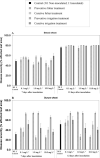Effect of amphotericin B nanodisks on plant fungal diseases
- PMID: 21710554
- PMCID: PMC3645367
- DOI: 10.1002/ps.2222
Effect of amphotericin B nanodisks on plant fungal diseases
Abstract
Background: The development of water-soluble nanodevices extends the potential use of compounds developed for other purposes (e.g. antifungal drugs or antibiotics) for applications in agriculture. For example, the broad-spectrum, water-insoluble, macrolide polyene antibiotic amphotericin B (AMB) could be used to inhibit phytopathogenic fungi. A new formulation embedding AMB in nanodisks (NDs) enhances antibiotic solubility and confers protection against environmental damage. In the present study, AMB-NDs were tested for efficacy against several phytopathogenic fungi in vitro and on infected living plants (chickpea and wheat).
Results: Compared with AMB in dimethylsulfoxide (DMSO), AMB-NDs increased the sensitivity of several fungal species to this antimycotic in vitro. Sensitivity varied with fungal species as well as with the forma specialis. Phytophthora cinnamomi, previously reported as insensitive to other polyene antimycotics, remained unaffected at the doses examined. Some effect against disease symptoms were obtained with AMB-NDs against fusarium wilt in chickpea, whereas the results were highly variable in wheat, depending on both the species and treatment regimen.
Conclusion: The results confirm that formulation of AMB into ND increases its effectiveness against phytopathogenic fungi in vitro, opening the possibility for its use on infected plants in the field.
Copyright © 2011 Society of Chemical Industry.
Figures
References
-
- Robinson DKR, Salejova-Zadrazilova G. [11 November 2010];Observatory NANO (2010) Nanotechnologies for Nutrient and Biocide Delivery in Agricultural Production. [Online]. Working Paper Version (April 2010). Available: http://www.observatorynano.eu/project/filesystem/files/Controlled%20deli....
-
- Wang L, Li X, Zhang G, Dong J, Eastoe J. Oil-in-water nanoemulsions for pesticide formulations. J Coll Int Sci. 2007;314:230–235. - PubMed
-
- Pérez-de-Luque A, Rubiales D. Nanotechnology for parasitic plant control. Pest Manag Sci. 2009;65:540–545. - PubMed
-
- Nair R, Varghese SH, Nair BG, Maekawa T, Yoshida Y, Kumar DS. Nanoparticulate material delivery to plants. Plant Sci. 2010;179:154–163.
-
- Tsuji K. Microencapsulation of pesticides and their improved handling safety. J Microencapsul. 2001;18:137–147. - PubMed
Publication types
MeSH terms
Substances
Grants and funding
LinkOut - more resources
Full Text Sources




